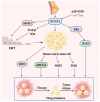Role of RUNX2 in breast cancer development and drug resistance (Review)
- PMID: 37033103
- PMCID: PMC10079821
- DOI: 10.3892/ol.2023.13762
Role of RUNX2 in breast cancer development and drug resistance (Review)
Abstract
Breast cancer is the most common malignancy and ranks second among the causes of tumor-associated death in females. The recurrence and drug resistance of breast cancer are intractable due to the presence of breast cancer stem cells (BCSCs), which are adequate to initiate tumor formation and refractory to conventional remedies. Runt-related transcription factor 2 (RUNX2), a pivotal transcription factor in mammary gland and bone development, has also been related to metastatic cancer and BCSCs. State-of-the-art research has indicated the retention of RUNX2 expression in a more invasive subtype of breast cancer, and in particular, triple-negative breast cancer development and drug resistance are associated with estrogen receptor signaling pathways. The present review mainly focused on the latest updates on RUNX2 in BCSCs and their roles in breast cancer progression and drug resistance, providing insight that may aid the development of RUNX2-based diagnostics and treatments for breast cancer in clinical practice.
Keywords: RUNX2; breast cancer; drug resistance; regulatory mechanism; stem cells.
Copyright: © Si et al.
Conflict of interest statement
The authors declare that they have no competing interests.
Figures

Similar articles
-
The significance of Runx2 mediating alcohol-induced Brf1 expression and RNA Pol III gene transcription.Chem Biol Interact. 2020 May 25;323:109057. doi: 10.1016/j.cbi.2020.109057. Epub 2020 Mar 18. Chem Biol Interact. 2020. PMID: 32198086 Free PMC article.
-
Exploring the interplay between triple-negative breast cancer stem cells and tumor microenvironment for effective therapeutic strategies.J Cell Physiol. 2024 Aug;239(8):e31278. doi: 10.1002/jcp.31278. Epub 2024 May 28. J Cell Physiol. 2024. PMID: 38807378 Review.
-
The Thyroid Hormone Receptor-RUNX2 Axis: A Novel Tumor Suppressive Pathway in Breast Cancer.Horm Cancer. 2020 Feb;11(1):34-41. doi: 10.1007/s12672-019-00373-2. Epub 2019 Dec 21. Horm Cancer. 2020. PMID: 31865591 Free PMC article.
-
Breast Cancer Stem-Like Cells in Drug Resistance: A Review of Mechanisms and Novel Therapeutic Strategies to Overcome Drug Resistance.Front Oncol. 2022 Mar 21;12:856974. doi: 10.3389/fonc.2022.856974. eCollection 2022. Front Oncol. 2022. PMID: 35392236 Free PMC article. Review.
-
ZGRF1 Is Associated with Poor Prognosis in Triple-Negative Breast Cancer and Promotes Cancer Stemness Based on Bioinformatics.Onco Targets Ther. 2020 Apr 3;13:2843-2854. doi: 10.2147/OTT.S234250. eCollection 2020. Onco Targets Ther. 2020. PMID: 32308418 Free PMC article.
Cited by
-
GSK3 acts as a switch for transcriptional programs in a model of low-grade gliomagenesis.Acta Neuropathol Commun. 2025 Apr 30;13(1):87. doi: 10.1186/s40478-025-02006-y. Acta Neuropathol Commun. 2025. PMID: 40307935 Free PMC article.
-
Notoginsenoside R1 (NGR1) regulates the AGE-RAGE signaling pathway by inhibiting RUNX2 expression to accelerate ferroptosis in breast cancer cells.Aging (Albany NY). 2024 Jun 14;16(12):10446-10461. doi: 10.18632/aging.205940. Epub 2024 Jun 14. Aging (Albany NY). 2024. PMID: 38885076 Free PMC article.
-
Unveiling Matrix Metalloproteinase 13's Dynamic Role in Breast Cancer: A Link to Physical Changes and Prognostic Modulation.Int J Mol Sci. 2025 Mar 27;26(7):3083. doi: 10.3390/ijms26073083. Int J Mol Sci. 2025. PMID: 40243781 Free PMC article. Review.
References
Publication types
LinkOut - more resources
Full Text Sources
